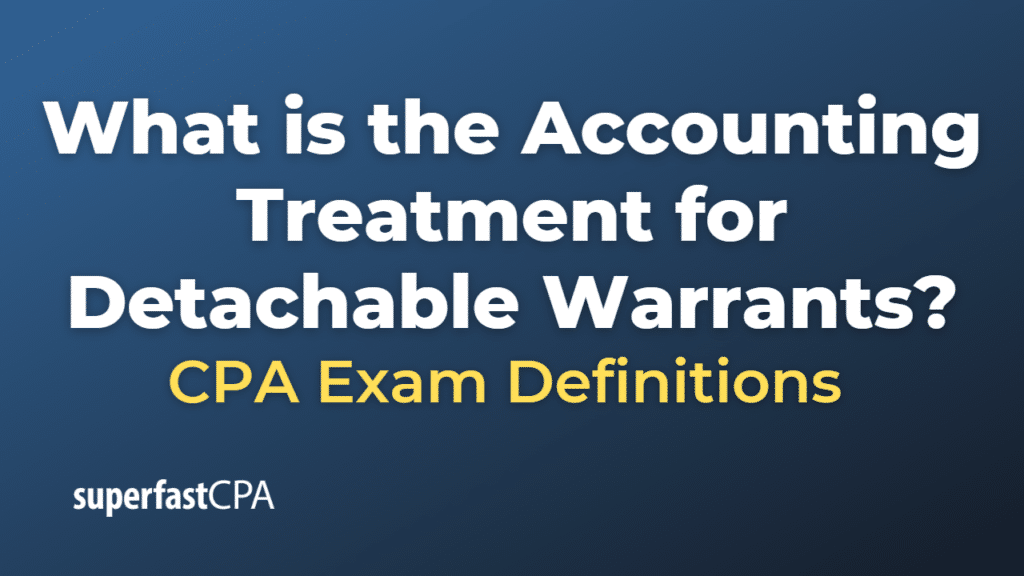Accounting Treatment for Detachable Warrants
When a company issues a bond or preferred stock with detachable warrants, it’s essentially issuing two separate securities: the bond (or preferred stock) and the warrant.
From an accounting perspective, these two components must be separately recorded on the company’s financial statements. The company has to allocate the proceeds from the sale of the security between the bond (or preferred stock) and the warrant. This is usually done based on their relative fair values.
Here’s a simplified example to illustrate:
- Suppose a company issues a $1,000 bond with a detachable warrant for $1,050 (the combined price for the bond and the warrant).
- Let’s say the fair value of a similar bond without a warrant is $950 and the fair value of a similar warrant is $150. The total fair value of the two components is $1,100.
- The company would then allocate the proceeds based on the relative fair values. The bond would be recorded at approximately $863 ($950 / $1,100 * $1,050), and the warrant would be recorded at approximately $187 ($150 / $1,100 * $1,050).
The bond or preferred stock is recorded as a liability (for bonds) or equity (for preferred stock), and the warrant is recorded as equity. This is because when (or if) the warrant is exercised, it will be converted into common stock.
It’s important to note that this is a simplified example. Actual accounting for detachable warrants can be more complex, and specific rules can vary by jurisdiction. Additionally, the fair value of a warrant might be estimated using option pricing models, which involve various assumptions and estimates.
As for the investors, when they exercise the warrants, they debit (reduce) the warrant equity account and credit (increase) the common stock and additional paid-in capital accounts, reflecting the issuance of new common stock. If they let the warrant expire, the balance in the warrant equity account would be reclassified within equity, since the company’s obligation to issue shares at the warrant price has been extinguished.
Example of the Accounting Treatment for Detachable Warrants
Let’s provide an example of how the accounting treatment for detachable warrants would look.
Let’s say XYZ Company issues 1,000 bonds with a face value of $1,000 each (raising $1,000,000 in total), and each bond is issued with a detachable warrant. The bond with the attached warrant is sold for $1,100.
XYZ Company determines the fair value of similar bonds (without warrants) is $950, and the fair value of the warrant, if it were sold separately, is $150. The combined fair value of the bond and the warrant, based on these valuations, is $1,100.
The company would then allocate the proceeds from the sale of each bond with its detachable warrant based on the relative fair values:
- The bond’s value would be recorded as: ($950 / $1,100) * $1,100 = $950
- The warrant’s value would be recorded as: ($150 / $1,100) * $1,100 = $150
These calculations are done for each bond and its attached warrant, so in our example, XYZ Company would record:
- Bonds payable (a liability) of $950,000 (1,000 bonds * $950 each)
- Additional paid-in capital (equity) for the warrants of $150,000 (1,000 warrants * $150 each)
Suppose an investor exercises their warrants at a later date when the stock price is higher than the strike price. The investor pays the strike price, and in exchange, XYZ Company issues new common stock. The accounting entry for the company at the exercise would be:
- Debit (decrease) additional paid-in capital – warrants for the amount originally allocated to the warrants (in our case, $150 per warrant)
- Credit (increase) common stock for the par value of the newly issued shares
- Credit (increase) additional paid-in capital – common stock for the excess of the amount received over the par value of the shares
If the warrant expires unexercised, the balance in the warrant equity account would be reclassified within equity.












